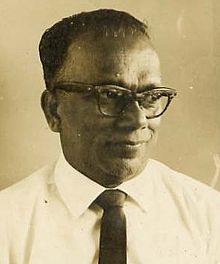- Villayil Raman Gopala Pillai
-
VR Gopala Pillai (1915-1981) was a Singaporean novelist writing in Malayalam under the nom de plume G.P. Njekkad, after his natal village in Kerala.
Contents
Background
Married to Bhargavi Pillai, he migrated to Singapore from Kerala, India in 1947. He had five children including Singaporean poet Chandran Nair.
Pillai worked as a manager-cum-accountant for Cathay Advertising in Singapore. An only child, Pillai had a fairly good education despite family objections based on astrological beliefs. He was formally schooled up to the age of 12. Pillai was a self-taught man, reading feverishly all kinds of books (especially Bengali novels translated into Malayalam) from a young age. "An author or a novelist must be well-read before he attempts to write himself", he told "Asiaweek" in an interview in 1981.
Career
As a teenager, Pillai had several short stories rejected but he persevered, writing lighter satires. His first published story was in 1932 where he criticised the caste system. He kept himself occupied with articles and short fiction until 1962 when his first novel was published. Entitled "Kaithapookal" (Tainted Flowers), it was set entirely in Kerala. This was followed by "Maruppachakal" (Barrier of Sand), "Vruthabhangam" (Unbalanced Life), "Thapasu" (Meditation), "Agniparvatham (Volcano),"Vazhiyariyathe" (Journey without Signs) and "Aavarthanam" (Repetition) which proved to be a best-seller. Many of these novels dealt with human relationships interwoven with the social fabric and were set in Singapore. His last novel, "Chirakudal Chalanangal" (Wings and Movements), was serialised by Kerala's then leading weekly, "Mathrubhoomi" (Motherland).
From 1949 to 1952 he took over the editorship of the Malayalam daily "Kerala Bandhu" (friend of Kerala) later known as "Malaysia Malayali" which had a combined Malaysia-Singapore circulation of about 2000.
Pillai will be remembered back in Kerala as a "popular" novelist. His nine novels, though mostly set in Singapore and Malaysia, appealed to Malayali readers because of their immigrant "rag-to-riches" leitmotif. His main characters were mostly from kerala but he often incorporated other communities too, like the Chinese, into the picture. The reader in relatively poorer Kerala was exposed to a world very different from what he was accustomed to. That was the attraction of Pillai's novels.
Another leitmotif of Pillai's works was the evident feminism running throughout his works. "I am a woman's man; 75% to 90% of my characters are female", he confessed to "Asiaweek"'s Jagjit Kaur Nagpal on his hospital bed. Perhaps as a legacy of Kerala's historical matrilineal system under which Malayali women enjoyed high social status, or perhaps because of Pillai's experiences as a field assistant in a Keralan tea estate where tea-pickers were mostly women who toiled under appalling conditions, Pillai displayed a sympathetic attitude in many of his works towards the oppressive plight of women. "The female character is always growing in my mind", he said, "her actions and everything about her". . ."It is something (his feminism) very natural to me; it is a habit. For instance, if there are two persons in a race --a man and a woman-- my attention will automatically go to the woman!" He attempted to write against women once but in the end relented: His intention was to portray an unpleasant, grumbling female but his dedication finally read "to one who keeps honey in the heart and chili on the tongue".
Pillai died shortly after the interview with "Asiaweek" of a second heart attack at the age of 66. He was remembered and regretted by the local Keralan community in Singapore who lost their prominent Malayam writer; one who managed to gain both critical appreciation and commercial success in India's highly competitive literary circles.
Works
Novels
- "Kaithapookal" (Tainted Flowers), Writers' Cooperative, Kerala, 1962
- "Maruppachakal" (Barrier of Sand), Writers' Cooperative, Kerala,
- "Vruthabhangam" (Unbalanced Life), Writers' Cooperative, Kerala,
- "Thapasu" (Meditation), Writers' Cooperative, Kerala,
- "Agniparvatham (Volcano), Writers' Cooperative, Kerala,
- "Vazhiyariyathe" (Journey without Signs), Writers' Cooperative, Kerala,
- "Aavarthanam" (Repetition), Writers' Cooperative, Kerala,
- "Chirakudal Chalanangal" (Wings and Movements), Writers' Cooperative, Kerala,
References
- Living and Dying Offshore by Jagjit Kaur Nagpal, Asiaweek Magazine, 6 March 1981
- The Individual in Society by Assif Shameen, Asiaweek Magazine, 22 May 1980
See also
Categories:- 1915 births
- 1981 deaths
- Singaporean people
- Singaporean writers
- Singaporean people of Indian descent
- Singaporean Hindus
Wikimedia Foundation. 2010.

